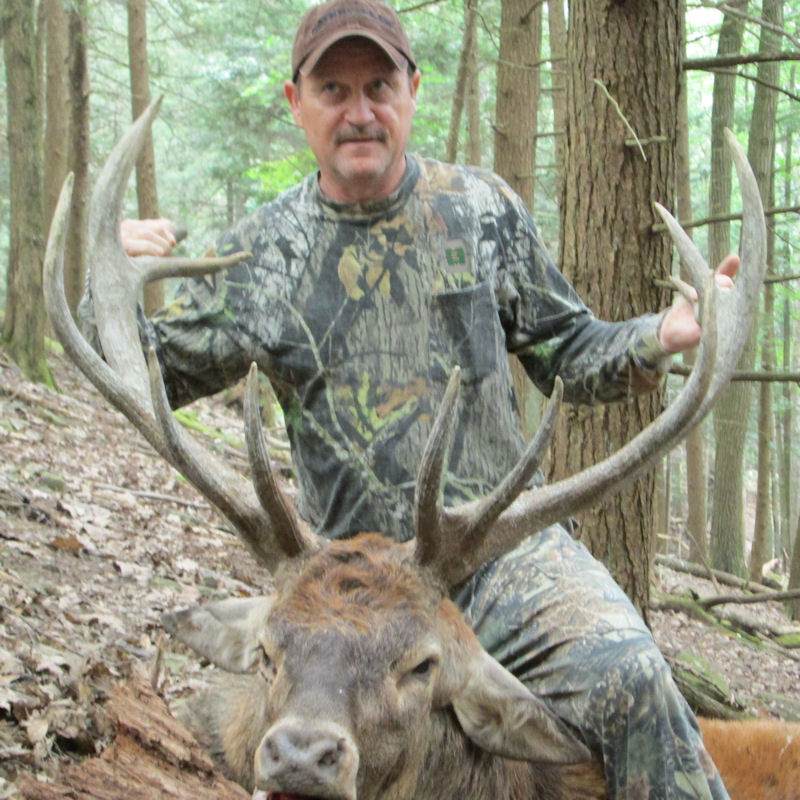
For many hunters, the thrill of red stag hunting lies not only in the moment of the shot but in the pursuit that comes with it, including the tracking, observation, and strategy that lead you to a mature, trophy-class animal. Tracking and identifying red stag deer is both an art and a science.
Tioga Ranch in Pennsylvania provides hunters with the unique opportunity to refine these skills under the guidance of experts who understand the nuance of red stag movement and behavior. Red stags are intelligent, cautious, and highly attuned to their surroundings. Understanding their daily habits is the first step to tracking them effectively.
Generally, red stags are most active during the early morning and late evening hours, when temperatures are cooler, and human activity is low. They feed on grasses, shrubs, and agricultural crops, and they often bed down during the heat of the day in shaded, thickly wooded areas.
During the rutting season, which typically occurs in the fall, these patterns change dramatically. Males become more vocal, more visible, and more likely to move throughout the day as they compete for territory and mates. This increased activity gives hunters a better chance to spot and follow stags. While red stag are sometimes mistaken for elk due to their similar size and coloring, experienced hunters know the key differences in antler shape, body build, and behavior.
Reading the Signs: Tracks, Rubs, and Droppings
Every red stag leaves a trail of clues for those who know what to look for. By learning to read these signs, you can narrow down where stags are feeding, bedding, and moving.
Tracks
Red stag tracks are similar to other large deer but broader and more rounded at the tips. Mature stags often leave deeper impressions due to their weigh, as they can weigh over 400 pounds! Fresh tracks will have sharp edges and may contain moisture, while older ones will appear dry or slightly eroded. Look for patterns that suggest direction of travel, gait, and whether the animal was walking, trotting, or running.
Rubs and Scrapes
Male red stags frequently rub their antlers against trees and shrubs to mark territory, strengthen neck muscles, and remove velvet during the late summer. These rubs can on tree trunks, usually between two and four feet above the ground. Scrapes—areas where stags paw the ground to expose soil are also key territorial markers, often found near bedding or feeding zones.
Droppings and Feeding Signs
Red stag droppings are usually oval-shaped and dark brown or black. Fresh droppings suggest recent activity in the area. You might also notice signs of feeding, such as broken stems, trampled grass, or browsed shrubs.
Using Calls, Scents, and Visual Cues
During the rut, communication plays a major role in red stag behavior. Learning to interpret and mimic their sounds can significantly improve your ability to locate and approach them. Red stags are known for their dee calls that can be heard from great distances. These vocalizations signal dominance and help stags gather harems of females. Hunters can use bugle calls to draw in dominant males or to provoke a territorial response.
Scent and Wind Direction
Scent plays a critical role in a red stag’s awareness of danger. Always hunt with the wind in your favor to avoid detection. Some hunters use scent-masking sprays or natural cover scents to reduce their human odor.
Visual Indicators
Red stags often leave subtle visual signs of their passage, such as bent grass, trampled leaves, or mud splashes on trees. Paying attention to these small details can help you track red stags.
Tools and Techniques for Tracking
Successful red stag tracking combines traditional woodsmanship with modern tools. A good pair of binoculars or a spotting scope is essential for scanning open areas, while trail cameras can help monitor patterns over time. GPS devices and mapping apps allow hunters to mark tracks, rubs, and bedding areas, building a clearer picture of the herd’s movement.
Book a Guided Red Stag Hunt Today
When you’re ready to put your tracking skills to the test, Tioga Ranch offers the perfect setting to do it; make your reservation for a guided red stag hunt today.
